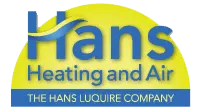
Simple Air Conditioner Troubleshooting Tips
During the hot Alabama summers, it’s possible to experience issues with your home’s cooling system. While Hans Heating and Air is always available to make fast repairs and restore comfort to your home, some system issues are easily solved without our help. In our most recent blog, you’ll find air conditioning troubleshooting tips straight from our pros to save you an unnecessary repair bill.
If Your Air Conditioner Isn’t Coming on at All…
For some, their first instinct is to panic when their home’s air conditioner doesn’t come on as expected. While such a problem could be caused by a breakdown that needs professional repair or an issue so serious the entire system needs to be replaced, sometimes it’s a lot simpler than that. When your cooling equipment doesn’t turn on, first check power sources and make sure the system and its components are properly powered.
1. Check Thermostat Power
Your thermostat sends all communication to the air conditioner, telling it to start and stop and how long to cycle. If the thermostat has a power issue, no signals are relayed to the air conditioner and it won’t turn on because it doesn’t know it should. Start AC troubleshooting by checking power to the thermostat.
- Is the display blank and nothing appears when you press buttons or adjust settings? If so, it might not have power.
- Remove the batteries, and replace them with fresh ones if your thermostat is battery powered. With new batteries in place, try adjusting the thermostat again to see if the display activates.
- For thermostats that are wired to the home’s electrical system, check the home’s electrical panel. The circuit breaker to the thermostat’s circuit could have tripped, stopping electricity from being sent through that circuit. Reset any tripped breakers to the ON position, and return to your thermostat to see if the display has activated.
- If your thermostat display comes back on, adjust the settings to tell the air conditioner to start.
- If these AC troubleshooting tips don’t power up your thermostat, it’s time for a new one in most cases. With wired thermostats, it is possible that there is a wiring issue preventing the thermostat from receiving power, but more than likely a new thermostat is necessary.
2. Check Power to Equipment
Your indoor and outdoor cooling system equipment needs power too, or else it won’t come on at all. If your central air conditioner did not start when you adjusted the thermostat settings after troubleshooting for power problems, it might be that your equipment doesn’t have power.
- Check the electrical panel for tripped breakers that have cut power to the indoor and outdoor units. Reset any tripped breakers.
- Locate the external power switches for the equipment. There will be an ON/OFF switch on or near the indoor unit, and likely on the exterior wall nearby the outdoor unit. Make sure the switch is toggled to the ON position.
- Go back to the thermostat and adjust settings to turn the cooling system on. Often, you’ll be good to go! If your air conditioning system still does not turn on, there are more complicated problems at play, and it’s time to call a technician.
If Your Air Conditioner Doesn’t Cycle When You Expect…
If your air conditioner does run but it doesn’t seem to cycle as expected, there could be a thermostat issue or filter problem at the heart of the malfunction. Troubleshooting for this issue also starts at the thermostat.
1. Check the Thermostat
Various thermostat issues can prevent the device from sending correct signals to your air conditioner. Despite programmed settings, you may notice the air conditioner doesn’t start a cycle until temperatures are a few degrees warmer or the air conditioner starts up again too soon even though the room is still at a comfortable temperature.
- Clean inside the thermostat. Dust and debris may settle on sensors which cause incorrect temperature readings – your thermostat thinks it is hotter than it actually is and will start up the air conditioner too soon, or it may read that temperatures are lower than reality so the air conditioner doesn’t come on until the actual temperature climbs higher than you’d like. Gently remove the faceplate and use compressed air in a can or a soft brush to clean components.
- Tighten wiring connections inside the thermostat. Loose wires can disrupt signals sent from the thermostat to the air conditioner.
- Make sure the thermostat sits level and flush with the wall. If the unit is knocked out of position, this may impact communications.
- Make sure the thermostat isn’t exposed to outside heat sources which could disrupt temperature readings. Heat sources such as open doors and windows or lamps affect how the thermostat reads temperatures. If you can’t remove the source of heat, your thermostat should be moved to a new location by an HVAC professional.
2. Check the Filter
If your AC unit was cycling but suddenly stopped and now will not come back on when it should, a dirty air filter could have caused the system to overheat. A dirty air filter restricts air movement through the unit, and components may reach high temperatures triggering the limit switch, which forces the equipment to shut down for a period of time as a safety precaution. Remove the filter and assess its condition, replacing it with a new one if necessary. Give the system time to cool. This air conditioning troubleshooting step should correct the issue if no other malfunctions exist.
Air Conditioner Repairs by Hans Heating and Air
Did our air conditioning troubleshooting steps work for you? Some air conditioner problems have simple solutions, but if the steps we described don’t get your cooling system working again, go ahead and give us a call. Our experienced HVAC repair technicians know how to get to the bottom of system issues. They perform diagnostics for a complete assessment of the issue and make targeted repairs to resolve equipment problems. Request a service appointment when you contact us today.
